Abstract
This study aims to present a systematic data-driven bibliometric analysis of the water hyacinth (Eichhornia crassipes) infestation problem around the globe. As many solutions are being proposed in academia for its management, mitigation, and utilization, it requires investigation through a systematic scrutinizing lens. In this study, literature records from 1977 to June 2020 concerning research on water hyacinth are taken from Scopus for text analysis. Trends in the publication of different article types, dynamics of publication, clustering, correlation, and co-authoring patterns between different countries are observed. The cluster analysis indicated four clusters viz. (i) ecological works related to species, (ii) pollutant removal process and methods, (iii) utilization of biofuels for biogas production, and (iv) modelling works. It is clear from the networking analysis that most of the publications regarding water hyacinth are from India, followed by China and the United States. Sentiment analysis with the AFINN lexicon showed that the negative sentiment towards the aquatic weed has intensified over time. An exploratory analysis was performed using a bigram network plot, depicting and outlining different important domains of water hyacinth research. Water hyacinth research has passed the pioneering phase and is now at the end of a steady growth phase or at the beginning of an acceleration phase. In this article, an overview is given for the entirety of water hyacinth research, with an indication of future trends and possibilities.
1. Introduction
Water hyacinth (Eichhornia sp.) is a floating aquatic macrophyte with large vascular tissue. It is well adapted to various environmental conditions and has a fast growth rate. It has high morphological elasticity as well as sexual and vegetative reproduction capabilities, helping its widespread persistence [1]. Because of such adaptable characteristics, it is highly invasive in nature, resulting in extensive damage to aquatic ecosystems.
This macrophyte, which is native to the Amazon River Basin, was introduced to the United States in 1884 and later, gradually, to Asia, Africa, Australia, and to other parts of the world. Currently, it is considered as a member of the world’s top 10 most invasive weeds [1]. Because of its rapid infestation and persistent distribution, its management and control has become an issue for many countries and regions, as well as a major challenge for academia to tackle.
Extensive research work has been performed regarding the effects of water hyacinth on the loss of water through evapotranspiration, navigation and fishing, and the blockage of irrigation and drainage systems [2,3,4], as well as on the phytoremediation of heavy metals and organic and inorganic pollutants via hyperaccumulation into the biomass [5]. Different measures for the eradication and management of the weed have been investigated, but, as it is extremely difficult to eradicate, most of the studies have focused on minimizing economic costs and ecological damage [6]. On the other hand, many studies suggest that controlling its damage will not suffice for successfully controlling the water hyacinth [7]. Its utilization and control ideally require economically sustainable and commercially viable and profitable outputs from its management through the valorization of its different components (cellulase, biopolymers etc.) or its conversion into energy (biogas, bioethanol, etc.) [7,8]. There are a diverse range of approaches being reported in the literature on water hyacinth worldwide, including different perspectives and approaches for its successful management for a sustainable future [9].
In such a scenario, a bibliometric- and text mining-based overview of water hyacinth research can provide a concise description and impression of the scientific activities associated with the eradication, sustainable utilization, and management of the weed. In this study, a bibliometric and text mining-based approach is used for the analysis of the vast amount of literature records available on water hyacinth in Scopus from 1977 up until June 2020, with special emphasis on the species Eichhornia crassipes. This study provides a general bibliometric overview of literature regarding the aquatic weed and aims to understand the mitigation strategies used or proposed for controlling and utilizing water hyacinth for energy, valorization of materials, and bioremediation through the time-scape.
2. Materials and Methods
2.1. Bibliographic Data Acquisition
The data for text mining were collected from Scopus with the following search command:
TITLE-ABS-KEY (water AND hyacinth) AND (LIMIT-TO (EXACTKEYWORD, “Eichhornia Crassipes”) OR LIMIT-TO (EXACTKEYWORD, “Water Hyacinth”))
This search reflects the results from the Scopus database that contain “water” and “hyacinth” in the title, abstract, or keywords, as well as keywords containing “Eichhornia crassipes” or “water hyacinth”, found in all of the available articles, conference proceedings, and books records. A total 2026 entries (from 1977–20 June 2020) were extracted from the database for analysis.
2.2. Statistical Packages
The bibliometric analysis of the Scopus records was conducted using statistical package VOSviewer 1.6.15 [10]. The statistical analysis was also conducted using R 3.6.2, [11] and statistical package “tidytext” [12]. For data visualization, package “ggplot2” [13] and “ggraph” [14] were used.
2.3. Clustering and Word Correlation
For clustering and network visualization, the title and abstract field were taken while omitting abstract labels and copyright statements. Binary counting method (only presence or absence of the term matters), terms, or noun phrases occurring at least 20 times were taken. Out of 463 terms, 278 (i.e., 60%) terms were visualized. For further validation and exploration of the clusters, the phi-coefficient from the words occurring in each document, by combining the title and abstract of the dataset and excluding the numbers and stop words (words that are not useful for an analysis, such as “the”, “of”, and “to”), were observed. Only prominent words (words that occurred more than 20 times) were used for correlation purposes. As explained by Silge et al., [12], the phi-coefficient for correlation is a measure of how likely it is that two words will appear simultaneously, or that they will not appear without each other. The value of the phi-coefficient is calculated by the following Equation:
here, n11 represents the number of documents where both words upon which the correlation is being calculated are present, n00 represents where none of them are present, and n01 and n10 represent cases where one is present while the other is absent. The other values n1., n0., n.0, n.1 are the sum of n11 and n10, n01 and n00, n10 and n00, and n10 and n01, respectively.
2.4. Co-Authorship Links among Countries
Co-authorship relations between countries are also visualized using the full counting method (each link having equal weighing), which produced at least five papers. By this criterion, out of all 104 countries available in the dataset, 54 met the threshold. Among the 54, only the countries with collaborations with other countries were visualized.
2.5. Sentiment Analysis
For conducting the sentiment analysis, the abstract, title, author keywords, and index keyword were taken, while all the numeric values and common stop words were excluded from the text dataset, and the popular general-purpose lexicon “AFINN” [15] was used. It is a collection of English terms rated manually with an integer between −5 (most negative) and +5 (most positive) by Finn Årup Nielsen. The dataset was divided into two parts based on their negative and positive sentiments and was processed separately. The trend in sentiment (1977–2020) was analyzed for the study dataset based on the following Euqation for each year.
here, TSS is the total sentiment score in a single year, ni is the number of occurrence of ith word, and SSi is the sentiment score of the word by AFINN lexicon. Based on the positive and negative sentiment, the term of Equation (2), is subtracted or added to neutralize the general trend in the increase of the total amount of literature (Figure 1).
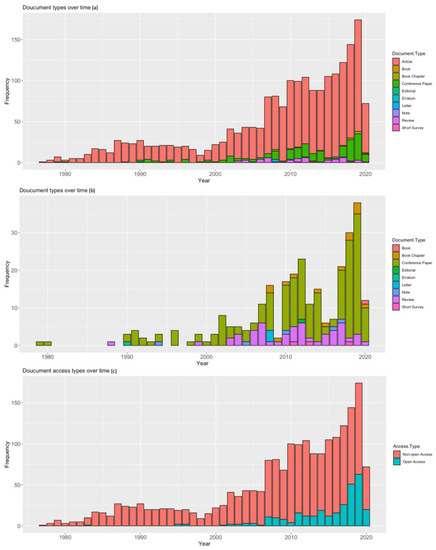
Figure 1.
(a) Number of publications types, (b) number of publications types excluding the type “article”, and (c) access types of publication possessing an association with water hyacinth from 1977 to June 2020.
2.6. Bi-Gram Network and Trends of Selective Words
For visualizing the bigram and selective word trends, the abstract, title, author keywords, and index keyword were taken, while all of the numeric values and common stop words were excluded from the text dataset. For exploring the relationships between words, the bigram, which tokenizes by pairs of adjacent words, was analyzed with a network plot. In addition, to understand the trends in the different study patterns, the occurrences of specific words like “biogas”, “phytoremediation”, etc., through time were observed. Before plotting such words, British English spellings were converted to American spellings and plural terms were converted to singular terms (fertiliser to fertilizer and fibre to fiber, and metals to metal, fibers to fiber, and briquettes to briquette) for an accurate representation of the word occurrences over time. Apart from spelling corrections, all of the words containing possible “bio” at the beginning (bioethanol, biohydrogen, and bioslurry) are transformed to their non-organic parts (ethanol, hydrogen, and slurry). After the conversion, the frequency of specific word occurrences was calculated for each year bracket.
3. Results and Discussion
3.1. Temporal Trend
The research volume regarding water hyacinth is large, and it is still expanding. From Figure 1a,c, it is observed that from 1977 to the late 1990s, the total amount of literature, which was found by stacking up all of the different document types focused on water hyacinth, increased slowly and then became static. In the next period up until 2019, a steady growth in literature was observed, which clearly indicates academia’s growing interest in water hyacinth research. The year 2020 showed less results, as the data were taken up until June. Among the 10 types of documents (article, book, book chapter, conference paper, editorial, erratum, letter, notice, short survey, and review) shown in Figure 1a, articles remained the highest published document type (86% of all document types), followed by conference papers (10%) and reviews (2.6%). All of the other documents, which consisted of books, book chapters, erratum, editorials, notes, and short surveys, amounted to only 1.4% of all of the document types. This becomes more clear in Figure 1b, which is plotted without incorporating the article document type. Figure 1b also depicts that book chapters were regularly published from 2008 onwards. This could also be due to increased DOI assignments to book chapters during that time, which led to increased numbers of such records in the SCOPUS database. Figure 1c depicts that the published research is still dominated by non-open access papers (85% of all access types), but from 2000 onwards, open access papers gained rapid popularity. From Figure 1, in general, it can be clearly observed that from around 2000, interest in water hyacinth grew along with other different types of published documents and with the popularity of the open-access option. Apart from these, the top 30 most frequently named authors, 20 top-cited works, and 10 most occurring literature sources/journals with their publishing pattern over time were observed and are shown in the supplementary sheet of Figures S1–S3, respectively.
3.2. Publication Dynamics
For modelling publication dynamics, the exponential model was fitted to the publication count with years (Figure 2). The model y = a × exp(b × x) was fitted, and the corresponding statistical parameters are given in Table 1. From the table, it can be observed that the p-value t-statistics for both coefficients are highly significant, and R2 is satisfactory.
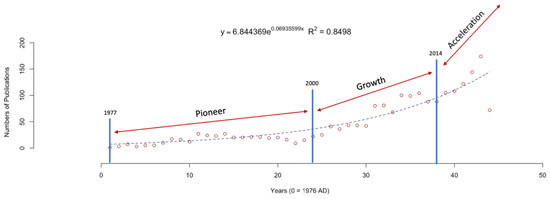
Figure 2.
Publication dynamics showing pioneering, growth, and acceleration phases.

Table 1.
Fitted exponential model parameters.
As discussed by Gautam [16], the research publication periods were divided into three periods, namely, the pioneering period, period of growth, and period of acceleration. The pioneering period is characterized by a low annual volume of publications with no distinct trend, followed by a period of growth that is characterized by a steady increase of publications. The third phase is characterized by a sudden burst of true exponential growth observed annually. This type of three-phase dynamic pattern is also observed in the research of Bickel [17] and Ma et al. [18], operating on a similar timescale in comparison with this study. Sonia et al. [19] showed that overall, the scientific production of the 12 most productive countries is also growing exponentially, even when some subject specific overall declines are present [20]. This indicates that characteristically, the topic of water hyacinth is following a similar exponential increase in publication outputs like that of the overall scientific publications [19], from its inception until now.
In the case of water hyacinth, a research pioneering period (first 24 years of publication from the first publication in 1977) and period of growth (from 25–38 years) can be recognized. Interestingly, from the 39th year onward, the hint of the beginning of a period of acceleration is also observed, but it is still not fully realized. According to such divisions, the dataset was divided into three periods (1977–2000, 2001–2014, and 2014–2020), and top 10 cited papers of each period were considered (Supplementary Tables S1–S3) for understanding the salient features of each period. In the pioneering period, eight studies were about the phytoremediation of pollutants with the help of water hyacinth, out of which six were on the phytoextraction of heavy metals from water bodies (Table S1). During the growth phase, studies seemed to diversify (Table S2) to the production of other materials from water hyacinth, such as capacitor fabrication [21], cellulose, ethanol production [22,23], and the production of compost [24]. Interestingly, in this period, the debate of water hyacinth should be looked as a problem or an opportunity to be taken advantage of took place in academia [6,7]. During the acceleration period (Table S3), further new approaches developed, like the production of biochar from water hyacinth and its use [25,26], textile industry waste treatment [27,28,29], and bio-oil production [30]. Phytoremediation techniques were carried over from the pioneering period to present time and the creation of different value-added materials were carried over to the present time from the growth period era. In general, it can be observed that the diversification of water hyacinth studies and the quest for other sustainable and environmentally friendly materials, apart from phytoremediation and energy production, are gaining popularity and will be the main driver of the acceleration period, where an explosive growth in research associated with the weed is expected.
3.3. Clusters and Correlation
Four prominent clusters are observed in Figure 3a, with distinguished characters that indicate different aspects of water hyacinth research. The first cluster (red) is centered around water hyacinth’s species and biology, while the second cluster (green), third cluster (blue), and fourth cluster (yellow) are centered around waste treatment, energy/material production, and modelling aspects, respectively. From the figure, four major themes of water hyacinth studies can be observed for the overall timeline. The topmost occurring terms for the four respective clusters are given in Table 2. From this table, it is clear that “production” is the highest occurring node with the highest links with other nodes, followed by “removal”, “species”, and “model”. For further exploration and validation of the observed themes, pairwise correlation with the help of the phi-coefficient was calculated for the cluster words given in Table 2. The top 10 most correlated words with “species”, “removal”, “production”, and “model” are plotted in Figure 3b.

Figure 3.
(a) Clusters and (b) pairwise correlation of the main cluster terms.

Table 2.
The topmost occurring terms from the four respective clusters of Figure 3a.
The highest correlated word with “species” was observed to be “invasive”, followed by other taxa like Pistia strotiates, Salvinia, which is also known to be invasive in nature [4]. The terms exotic, diversity, ecology, macrophyte, and abundance indicate the study areas of aquatic biology and the distribution of the weed. Works are also being performed on the effects of water hyacinth on phytoplankton, zooplankton, macro-invertebrate, fish, and bird populations [6].
As for the second cluster, the term “removal”, which has the highest link strength, is highly associated with the word “wastewater”. On the same note, “aqueous”, “removal”, “phytoremediation”, and “efficiency” are among the top correlated terms with “removal”. This clearly indicates that it focuses on wastewater treatment and phytoremediation by the weed water hyacinth. Substantial work has been performed on the phytoremediation and wastewater treatment capabilities of the weed [27,31,32,33].
In the third cluster, the term “production” is the highest occurring word, and has the highest link strength among the top terms of the clusters being compared. The term “production” is correlated with “biogas”, “digestion”, “methane”, and “yield”, as well as being related to “fermentation”, “bioethanol”, and “hydrolysis”, which shows that energy production plays a pivotal role in this area. A large volume of work is available in the area of biogas production and water hyacinth. Water hyacinth is often used as a substrate in the anaerobic digester for enhancing biogas production [34,35]. Water hyacinth is also utilized in bioethanol production through fermentation and saccharification [36].
The term “model” occurred the least out of the other top terms of clusters, with the lowest link and link strength. The correlation analysis showed that it is the term associated with different model types like “kinetic” and “Langmuir”, and with words like “data”, “fitted”, “mathematical”, etc. Different types of kinetic models are observed, such as kinetic model for wastewater treatment [37], growth kinetics of water hyacinth [38], and kinetic models for energy production from biogas [39].
3.4. Networks of Co-Authorship Countries
Figure 4 depicts the co-authorship relations among the countries conducting research on water hyacinth. From the size of the nodes, i.e., the countries are proportional to the numbers of publications, it is clear that most publications regarding water hyacinth are from India, followed by China and the United States. It can also be observed that countries like Indonesia, Saudi Arabia, Ethiopia, etc., are new to water hyacinth research, while USA, UK, Japan, France, etc., have older water hyacinth research on an average. India and China are in between these countries; however, India started research on water hyacinth earlier than China. Israel and the Russian federation are not visualized in Figure 4 because they have no collaborations with other countries.
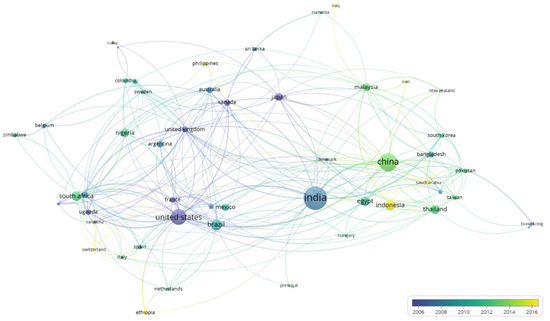
Figure 4.
Co-authorship relations among countries, with an average publication year as the color gradient.
Table 3 depicts the 10 topmost countries for the highest document production regarding water hyacinth. India produced 1.7 times and almost 2 times more publications than the USA and China, respectively, which are in the second and third positions according to publication volume. Average citation per document is the highest for the United States, followed by India and Egypt. According to links with different countries, India has the highest amount of collaborations with other countries, followed by the United States and China. It is observed that countries where water hyacinth is a serious problem tend to produce more work on water hyacinth [40].

Table 3.
Top 10 countries by document volume.
3.5. Sentiment Analysis
The data containing abstract, title, author keywords, and index keywords were used for the sentiment analysis. The frequency multiplied negative and positive sentiments score for the top 30 most occurring words from the dataset were observed for understanding their relative viability and appropriate application strategy. Figure 5 depicts both positive and negative sentiments. It can be observed that the negative sentiments clearly grasped water hyacinth functions and researchers’ perception about the weed, while positive sentiments are not particularly about the plant, but its mitigation/management/control related positive words. So, positive sentiments were discarded from analysis for understanding the net general sentiment associated with water hyacinth by researchers, and emphasis was given only to negative sentiments.
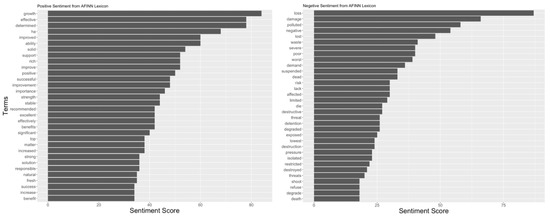
Figure 5.
Top 30 highest positive and negative scoring sentiment words in the dataset.
Figure 6 represents the increasing use of more intensive negative words to describe water hyacinth. As the total number of publications increased through time (Figure 1), it is also clear that the total number of words used to describe water hyacinth increased through time as well. So, the inflating word count needed to be adjusted from the total sentiment score to depict the intensity of changing negative emotions towards water hyacinth. Equation (2) was used in this case to obtain the increasing word adjusted negative lexicon scores. The value of 0 for the y-axis should depict the values being neutralized by the number of words marked as negative present in the literature. A lesser score than 0 for the y-axis value indicates the application of more intensive negative word usage in literature. So, according to AFINN lexicon score, it is clear that strongly negative words are used for depicting water hyacinth, and this trend increased rapidly from around the year 2000.
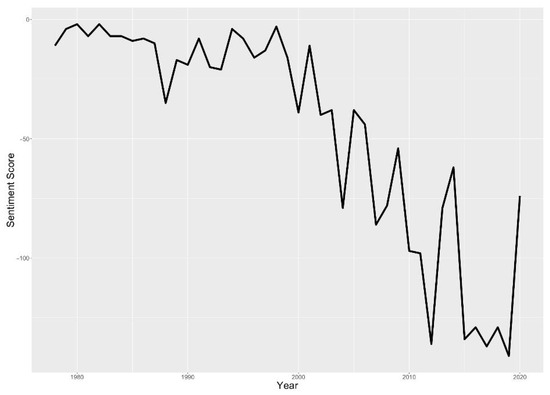
Figure 6.
Yearly trend in negative sentiment from AFINN lexicon sores.
3.6. Bigram Network and Specific Terms Trend Analysis
To visualize all of the relationships among the words, a network plot was constructed using a bigram. The plot was constructed using words that co-occurred more than 50 times. The network plot (Figure 7) shows that the biggest two nodes that the literature is structured around are “water” followed by “hyacinth”. This outcome was expected because of the search command used for searching the literature in Scopus, which was centered around these two words. From the plot, it can be observed that apart from “water” and “hyacinth”, the nodes were “waste”, “treatment”, “aquatic”, “plant”, “production”, and “removal”. It can be observed that this network plot also produced similar results to the clustering. Here, waste and treatment nodes are naturally connected to each other, and are further connected to different types of waste treatment mentioned in the literature, such as solid waste, sewage sludge, wastewater, and industrial waste, in association with water hyacinth. Other nodes such as “plant” are associated with words like “growth”, “root”, “biomass” [41], etc., and “production” is related to “hydrogen” [42], “biogas” [43], “ethanol” [36], etc. Apart from the major connected network, many isolated networks depict different techniques used by the researchers associated with water hyacinth, such as Fourier transform infrared spectroscopy [44], scanning electron microscopy [45], mass spectroscopy, and gas chromatography [46]. Aspects of modelling like “response surface methodology” [47], “remote sensing” [48], and “kinetic reaction” of water hyacinth research, along with “anaerobic digestion”, “low cost”, “bio-oil” [49], “renewable energy”, etc., were also observed to be in the literature.
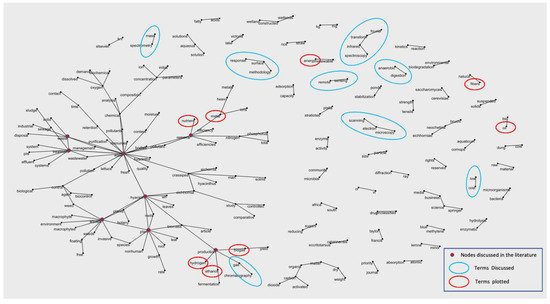
Figure 7.
Network plot of water hyacinth literature.
Term specific occurrences were also observed in the literature by getting specific words from the bigram network plot. Words associated with production nodes, such as “biogas”, “ethanol”, “hydrogen”, “removal node”, “metal”, and “nutrient”, and other isolated nodes like “energy”, “oil”, and “fiber” [44], were taken for observing their occurrence over time. Apart from these words, the expert’s opinion about work trends with other words like “biochar”, “briquette” [50], “combustion”, “phytoremediation”, “fertilizer”, “compost”, and “slurry” are plotted and depicted in Figure 8.
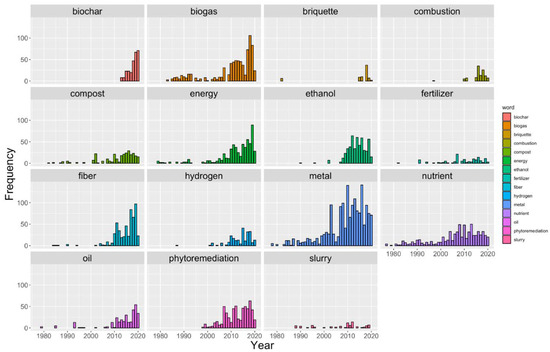
Figure 8.
Occurrence of different terms in water hyacinth research over time.
Figure 8 depicts that, among all of the other terms selected for plotting, the term “metal” remained the most prominent term, followed by “energy” and “nutrient”. As discussed in Section 3.2 and 3.3, “metal” depicts the removal or mining of heavy metals with water hyacinth from wastewater. From Figure 7, it can be observed that “energy” is directly connected to “renewable”, and “nutrient” is connected to “removal”. In the domain of energy, “biogas”, “hydrogen”, “ethanol”, and “bio-oil” are all renewable energy sources associated with the weed. Apart from nutrient removal, “compost”, “fertilizer”, and “slurry” represent important aspects of nutrient addition. Figure 8 depicts that biogas production from water hyacinth was the most prominent solution sought out by the community for the longest time after excess nutrient and heavy metal removal from water. As biogas was thought of as a solution for a long time, the concept of “slurry” and “fertilizer”, which are produced from biogas plants, are also fairly old. Interestingly, although old, these two topics are seemingly way less popular compared with biogas production, of which these were the end products. Ethanol, hydrogen production, fiber, oil extraction, and phytoremediation became popular around the same time in the year 2000, from when the overall interest for publication regarding water hyacinth increased. The concept of briquetting water hyacinth was first applied to water hyacinth research around the mid 1980s, but was not further discussed until recent years. As for the combustion of water hyacinth, which is deeply associated with water hyacinth briquettes [51] and the drying of water hyacinth [52], this was investigated mainly from the year 2000 onwards. In general, from the word trends of briquette and combustion, it is observed that the burning of water hyacinth biomass is not generally thought as a management choice. Interestingly, it can also be observed that “biochar” produced from water hyacinth [24], which involves the pyrolysis of the biomass, has become the most recent concept introduced to this research domain, and is currently gaining rapid popularity.
4. Conclusions
As water hyacinth is becoming exceedingly problematic over time, to cope with the challenge, the research associated with the problem is also increasing raidly. Water hyacinth research has passed the pioneering phase and is now at the end of a steady growth phase or at the beginning of the acceleration phase. This indicates that huge amounts of research are expected to be published in the near future with increasing diversity in the “production” domain. In addition, as the negative sentiment towards water hyacinth is increasing rapidly in the literature, it can be anticipated that in the future, “control by utilization” research centering water hyacinth will be more vigorous and will continue to increase at a rapid rate. From the cluster, correlation, and the bigram network plot, the prominent research areas and discourses can be observed and explored while getting a good overall picture of the research fields. As many concepts were introduced and became popular around the year 2000, this implies an increased participation of researchers. The approaches taken to mitigate and control water hyacinth have greatly diversified since the beginning of 21st century, and will rise sharply in the form of how it can be considered as a usable/profitable resource.
Supplementary Materials
The following are available online at https://www.mdpi.com/article/10.3390/informatics8020038/s1, Figure S1: Top 10 most cited literature, Figure S2: Top 10 most occurring literature sources & top 9 publisher publishing pattern over time, Figure S3: Top 30 most occurring authors in literature, Table S1: Top 10 cited documents of the pioneering period (1977–2000), Table S2: Top 10 cited documents of the growth period (2001–2014), Table S3: Top 10 cited documents of the growth period (2015–2020).
Author Contributions
Conceptualization, A.B. and S.B.; methodology, A.B.; software, A.B.; validation, A.B., A.B.R. and S.B.; formal analysis, A.B.; investigation, S.B. and S.C.; resources, S.B.; data curation, A.B. and S.B.; writing—original draft preparation, A.B., A.K.H. and S.C.; writing—review and editing, S.B. and S.C.; visualization, A.B.; supervision, S.B. and S.C.; project administration, A.B.R.; funding acquisition, A.B.R. All authors have read and agreed to the published version of the manuscript.
Funding
This research was funded by the Biotechnology and Biological Sciences Research Council (BBSRC; grant number BB/S011439/1) via the GCRF project BEFWAM (Bioenergy, Fertilizer, and Clean Water from Invasive Aquatic Macrophytes).
Institutional Review Board Statement
Not applicable.
Informed Consent Statement
Not applicable.
Acknowledgments
We thank Nyssa van Vierssen Trip (York University, Canada) for important conversations.
Conflicts of Interest
The authors declare no conflict of interest.
References
- Yan, S.; Guo, J.Y. Water Hyacinth: Environmental Challenges, Management and Utilization; CRC Press: Boca Raton, FL, USA, 2017. [Google Scholar]
- Benton, A.R.; James, W.P.; Rouse, J.W. EVAPOTRANSPIRATION FROM WATER HYACINTH (Eichhomia crassipes (Mart.) Solms) IN TEXAS RESERVOIRS. J. Am. Water Resour. Assoc. 1978, 14, 919–930. [Google Scholar] [CrossRef]
- Gopal, B. Water Hyacinth; Elsevier: Amsterdam, The Netherlands, 1987; 477p. [Google Scholar]
- Holm, L.G.; Plucknett, D.L.; Pancho, J.V.; Herberger, J.P. The World’s Worst Weeds, Distribution and Biology; Krieger Publishing Co.: Malabar, FL, USA, 1991. [Google Scholar]
- Rezania, S.; Ponraj, M.; Talaiekhozani, A.; Mohamad, S.E.; Md Din, M.F.; Taib, S.M.; Sabbagh, F.; Md Sairanab, F. Perspectives of phytoremediation using water hyacinth for removal of heavy metals, organic and inorganic pollutants in wastewater. J. Environ. Manag. 2015, 163, 125–133. [Google Scholar] [CrossRef]
- Villamagna, A.M.; Murphy, B.R. Ecological and socio-economic impacts of invasive water hyacinth (Eichhornia crassipes): A review. Freshw. Biol. 2010, 55, 282–298. [Google Scholar] [CrossRef]
- Malik, A. Environmental challenge vis a vis opportunity: The case of water hyacinth. Environ. Int. 2007, 33, 122–138. [Google Scholar] [CrossRef] [PubMed]
- Sindhu, R.; Binod, P.; Pandey, A.; Madhavan, A.; Alphonsa, J.A.; Vivek, N.; Gnansounou, E.; Castro, E.; Faraco, V. Water hyacinth a potential source for value addition: An overview. Bioresour. Technol. 2017, 230, 152–162. [Google Scholar] [CrossRef] [PubMed]
- Rezania, S.; Ponraj, M.; Din, M.F.M.; Songip, A.R.; Sairan, F.M.; Chelliapan, S. The diverse applications of water hyacinth with main focus on sustainable energy and production for new era: An overview. Renew. Sustain. Energy. Rev. 2015, 41, 943–954. [Google Scholar] [CrossRef]
- VOSviewer: Visualizing scientific landscapes. Available online: https://www.vosviewer.com (accessed on 4 June 2021).
- Team, R.C. The R Project for Statistical Computing. Available online: https://www.r-project.org (accessed on 4 June 2021).
- Silge, J.; Robinson, D. Text Mining with R: A Tidy Approach; O’Reilly Media, Inc.: Sebastopol, CA, USA, 2017. [Google Scholar]
- Wickham, H. A Layered Grammar of Graphics. J. Comput. Graph. Stat. 2010, 19, 3–28. [Google Scholar] [CrossRef]
- Ggraph: An Implementation of Grammar of Graphics for Graphs and Networks. Available online: https://cran.r-project.org/web/packages/ggraph/index.html (accessed on 4 June 2021).
- AFINN Sentiment Lexicon. Available online: http://corpustext.com/reference/sentiment_afinn.html (accessed on 4 June 2021).
- Gautam, P. An overview of the Web of Science record of scientific publications (2004–2013) from Nepal: Focus on disciplinary diversity and international collaboration. Scientometrics 2017, 113, 1245–1267. [Google Scholar] [CrossRef]
- Bickel, M.W. Reflecting trends in the academic landscape of sustainable energy using probabilistic topic modeling. Energy Sustain. Soc. 2019, 9, 1–23. [Google Scholar] [CrossRef]
- Ma, W.; Schraven, D.; de Bruijne, M.; de Jong, M.; Lu, H. Tracing the Origins of Place Branding Research: A Bibliometric Study of Concepts in Use (1980–2018). Sustainability 2019, 11, 2999. [Google Scholar] [CrossRef]
- Monroy, S.E.; Diaz, H. Time series-based bibliometric analysis of the dynamics of scientific production. Scientometrics 2018, 115, 1139–1159. [Google Scholar] [CrossRef]
- Mabe, M.; Amin, M. Growth dynamics of scholarly and scientific journals. Scientometrics 2001, 51, 147–162. [Google Scholar] [CrossRef]
- Senthilkumar, S.T.; Selvan, R.K.; Lee, Y.S.; Melo, J.S. Electric double layer capacitor and its improved specific capacitance using redox additive electrolyte. J. Mater. Chem. A 2013, 1, 1086–1095. [Google Scholar] [CrossRef]
- Sukumaran, R.K.; Singhania, R.R.; Mathew, G.M.; Pandey, A. Cellulase production using biomass feed stock and its application in lignocellulose saccharification for bio-ethanol production. Renew. Energy 2009, 34, 421–424. [Google Scholar] [CrossRef]
- Nigam, J.N. Bioconversion of water-hyacinth (Eichhornia crassipes) hemicellulose acid hydrolysate to motor fuel ethanol by xylose-fermenting yeast. J. Biotechnol. 2002, 97, 107–116. [Google Scholar] [CrossRef]
- Goyal, S.; Dhull, S.; Kapoor, K. Chemical and biological changes during composting of different organic wastes and assessment of compost maturity. Bioresour. Technol. 2005, 96, 1584–1591. [Google Scholar] [CrossRef]
- Yin, D.; Wang, X.; Chen, C.; Peng, B.; Tan, C.; Li, H. Varying effect of biochar on Cd, Pb and As mobility in a multi-metal contaminated paddy soil. Chemosphere 2016, 152, 196–206. [Google Scholar] [CrossRef] [PubMed]
- Zhang, F.; Wang, X.; Yin, D.; Peng, B.; Tan, C.; Liu, Y.; Tan, X.; Wu, S. Efficiency and mechanisms of Cd removal from aqueous solution by biochar derived from water hyacinth (Eichornia crassipes). J. Environ. Manag. 2015, 153, 68–73. [Google Scholar] [CrossRef]
- Sanmuga Priya, E.; Senthamil Selvan, P. Water hyacinth (Eichhornia crassipes)—An efficient and economic adsorbent for textile effluent treatment—A review. Arab. J. Chem. 2017, 10, S3548–S3558. [Google Scholar] [CrossRef]
- El-Zawahry, M.M.; Abdelghaffar, F.; Abdelghaffar, R.A.; Hassabo, A.G. Equilibrium and kinetic models on the adsorption of Reactive Black 5 from aqueous solution using Eichhornia crassipes/chitosan composite. Carbohydr. Polym. 2016, 136, 507–515. [Google Scholar] [CrossRef]
- Guerrero-Coronilla, I.; Morales-Barrera, L.; Cristiani-Urbina, E. Kinetic, isotherm and thermodynamic studies of amaranth dye biosorption from aqueous solution onto water hyacinth leaves. J. Environ. Manag. 2015, 152, 99–108. [Google Scholar] [CrossRef] [PubMed]
- Singh, R.; Balagurumurthy, B.; Prakash, A.; Bhaskar, T. Catalytic hydrothermal liquefaction of water hyacinth. Bioresour. Technol. 2015, 178, 157–165. [Google Scholar] [CrossRef]
- Ting, W.H.T.; Tan, I.A.W.; Salleh, S.F.; Wahab, N.A. Application of water hyacinth (Eichhornia crassipes) for phytoremediation of ammoniacal nitrogen: A review. J. Water Process. Eng. 2018, 22, 239–249. [Google Scholar] [CrossRef]
- Dhote, S.; Dixit, S. Water quality improvement through macrophytes—A review. Environ. Monit. Assess. 2009, 152, 149–153. [Google Scholar] [CrossRef]
- Gupta, G.C. Use of water hyacinths in wastewater treatment. (A brief literature review). J. Environ. Health 1980, 43, 80–82. [Google Scholar]
- Gunnarsson, C.C.; Petersen, C.M. Water hyacinths as a resource in agriculture and energy production: A literature review. Waste Manag. 2007, 27, 117–129. [Google Scholar] [CrossRef] [PubMed]
- Yadvika; Santosh; Sreekrishnan, T.R.; Kohli, S.; Rana, V. Enhancement of biogas production from solid substrates using different techniques—A review. Bioresour. Technol. 2004, 95, 1–10. [Google Scholar] [CrossRef]
- Ganguly, A.; Chatterjee, P.K.; Dey, A. Studies on ethanol production from water hyacinth—A review. Renew. Sustain. Energy Rev. 2012, 16, 966–972. [Google Scholar] [CrossRef]
- Polprasert, C.; Khatiwada, N.R. An integrated kinetic model for water hyacinth ponds used for wastewater treatment. Water Res. 1998, 32, 179–185. [Google Scholar] [CrossRef]
- Musil, C.F.; Breen, C.M. The application of growth kinetics to the control of Eichhornia crassipes (Mart) solms. Through nutrient removal by mechanical harvesting. Hydrobiologia 1977, 53, 165–171. [Google Scholar] [CrossRef]
- Yusuf, M.O.L.; Ify, N.L. The effect of waste paper on the kinetics of biogas yield from the co-digestion of cow dung and water hyacinth. Biomass Bioenergy 2011, 35, 1345–1351. [Google Scholar] [CrossRef]
- UNEP Global Environmental Alert Service (GEAS); Theuri, M. Water Hyacinth: Can its Aggressive Invasion Be Controlled? Environ. Dev. 2013, 7, 139–154. Available online: https://wedocs.unep.org/20.500.11822/8483 (accessed on 4 June 2021).
- Eid, E.M.; Shaltout, K.H. Growth dynamics of water hyacinth (Eichhornia crassipes): A modeling approach. Rend. Lincei 2017, 28, 169–181. [Google Scholar] [CrossRef]
- Rezania, S.; Din, M.F.M.; Taib, S.M.; Sohaili, J.; Chelliapan, S.; Kamyab, H.; Baran Saha, B. Review on fermentative biohydrogen production from water hyacinth, wheat straw and rice straw with focus on recent perspectives. Int. J. Hydrogen Energy 2017, 42, 20955–20969. [Google Scholar] [CrossRef]
- Mathew, A.K.; Bhui, I.; Banerjee, S.N.; Goswami, R.; Chakraborty, A.K.; Shome, A.; Balachandran, S.; Chaudhury, S. Biogas production from locally available aquatic weeds of Santiniketan through anaerobic digestion. Clean Technol. Environ. Policy 2015, 17, 1681–1688. [Google Scholar] [CrossRef]
- Thiripura Sundari, M.; Ramesh, A. Isolation and characterization of cellulose nanofibers from the aquatic weed water hyacinth —Eichhornia crassipes. Carbohydr. Polym. 2012, 87, 1701–1705. [Google Scholar] [CrossRef]
- Kelley, C.; Mielke, R.E.; Dimaquibo, D.; Curtis, A.J.; Dewitt, J.G. Adsorption of Eu (III) onto roots of water hyacinth. Environ. Sci. Technol. 1999, 33, 1439–1443. [Google Scholar] [CrossRef]
- Shanab, S.M.M.; Shalaby, E.A.; Lightfoot, D.A.; El-Shemy, H.A. Allelopathic Effects of Water Hyacinth [Eichhornia crassipes]. PLoS ONE 2010, 5, e13200. [Google Scholar] [CrossRef]
- Das, S.; Bhattacharya, A.; Haldar, S.; Ganguly, A.; Gu, S.; Ting, Y.P.; Chatterjee, P.K. Optimization of enzymatic saccharification of water hyacinth biomass for bio-ethanol: Comparison between artificial neural network and response surface methodology. Sustain. Mater. Technol. 2015, 3, 17–28. [Google Scholar] [CrossRef]
- Thamaga, K.H.; Dube, T. Remote sensing of invasive water hyacinth (Eichhornia crassipes): A review on applications and challenges. Remote Sens. Appl. Soc. Environ. 2018, 10, 36–46. [Google Scholar] [CrossRef]
- Biswas, B.; Singh, R.; Krishna, B.B.; Kumar, J.; Bhaskar, T. Pyrolysis of azolla, sargassum tenerrimum and water hyacinth for production of bio-oil. Bioresour. Technol. 2017, 242, 139–145. [Google Scholar] [CrossRef] [PubMed]
- Munjeri, K.; Ziuku, S.; Maganga, H.; Siachingoma, B.; Ndlovu, S. On the potential of water hyacinth as a biomass briquette for heating applications. Int. J. Energy Environ. Eng. 2016, 7, 37–43. [Google Scholar] [CrossRef]
- Davies, R.M.; Davies, O.A. Physical and Combustion Characteristics of Briquettes Made from Water Hyacinth and Phytoplankton Scum as Binder. J. Combust. 2013, 2013, 549894. [Google Scholar] [CrossRef]
- Pimchuai, A.; Dutta, A.; Basu, P. Torrefaction of agriculture residue to enhance combustible properties. In Energy and Fuels, Volume 24; American Chemical Society: Washington, DC, USA, 2010; pp. 4638–4645. [Google Scholar] [CrossRef]
Publisher’s Note: MDPI stays neutral with regard to jurisdictional claims in published maps and institutional affiliations. |
© 2021 by the authors. Licensee MDPI, Basel, Switzerland. This article is an open access article distributed under the terms and conditions of the Creative Commons Attribution (CC BY) license (https://creativecommons.org/licenses/by/4.0/).